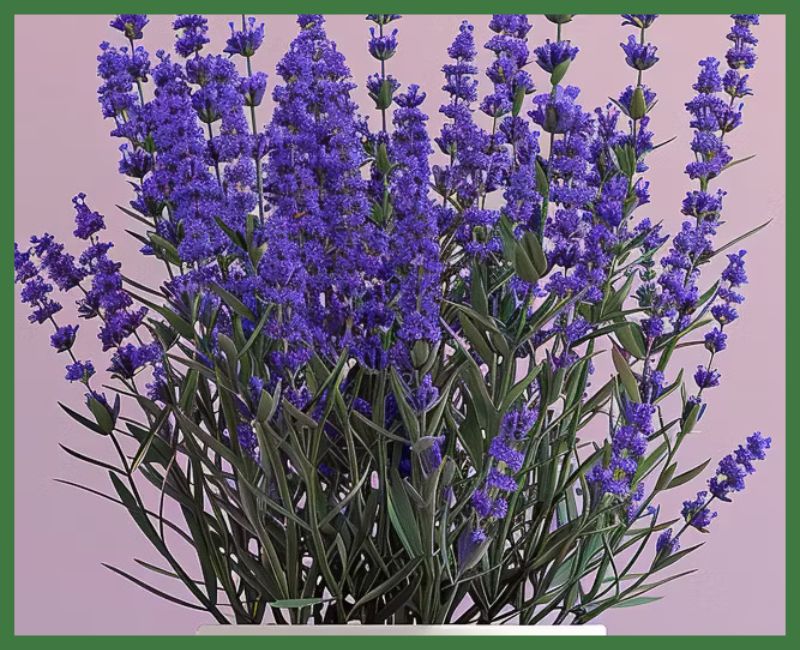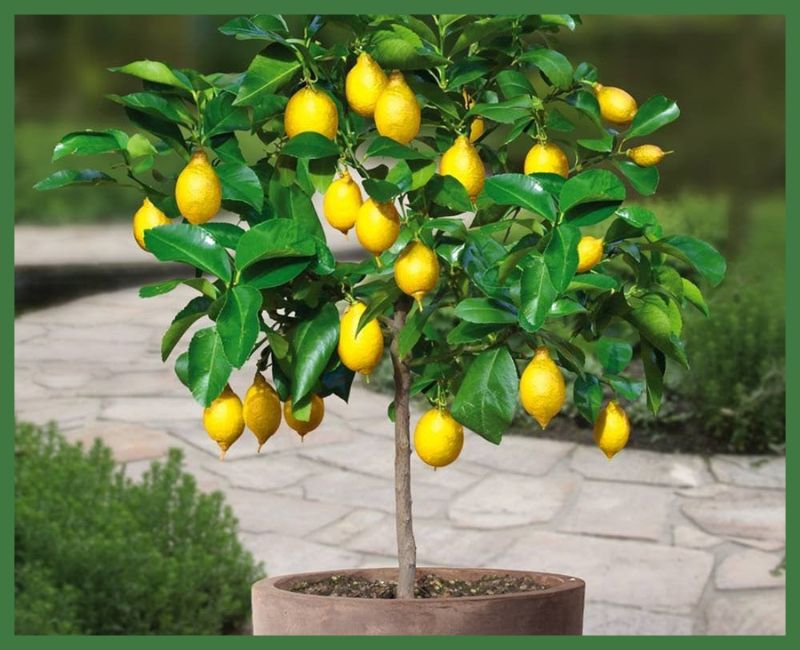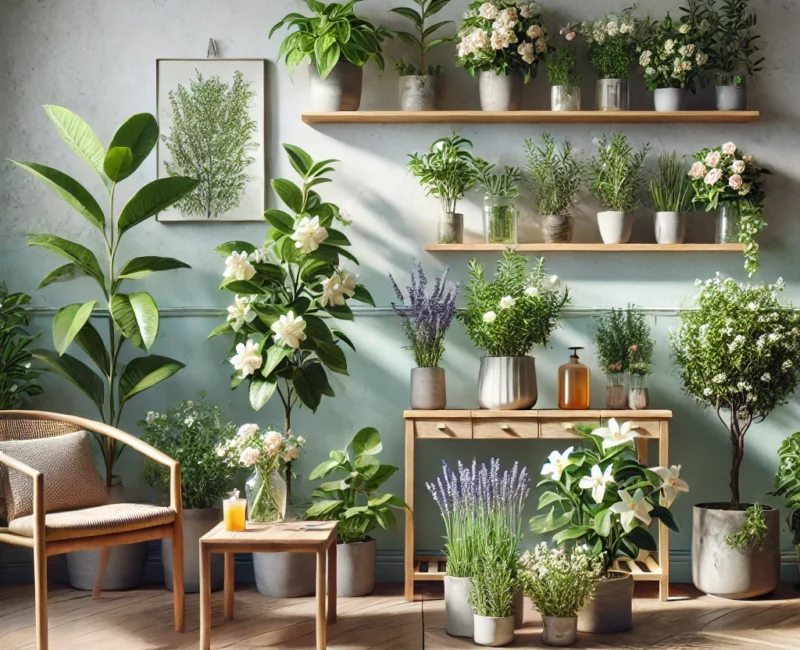Indoor plants do more than just decorate your living space; they bring a touch of nature indoors and, in some cases, fill your home with delightful fragrances. A well-chosen fragrant plant can turn your home into a serene, aromatic haven. Whether you’re looking to invigorate your senses or create a calming atmosphere, there’s a plant for every preference. Let’s explore some of the best smelling indoor plants that can enhance the ambiance of your home.
1. Jasmine

Jasmine is celebrated for its enchanting scent, which becomes more potent in the evening. The plant’s small, star-shaped flowers come in white or pink and are often used in perfumes and teas.
Detailed Care Tips for Jasmine:
- Light: Jasmine thrives in bright, indirect light. Placing it near a south-facing window ensures it receives adequate light without being scorched by direct sun.
- Water: Maintain consistently moist soil. It’s best to water jasmine when the top inch of soil feels dry, ensuring the roots are never waterlogged.
- Temperature: This plant prefers temperatures between 60-75°F (15-24°C). It doesn’t do well in extreme cold or heat, so keep it away from drafts or direct heat sources.
- Fertilizer: Use a balanced fertilizer every two weeks during the growing season to encourage blooming.
2. Gardenia

Gardenia’s rich, sweet fragrance and stunning white flowers make it a favorite among plant enthusiasts. Though a bit finicky, with the right care, gardenias can be a rewarding addition to your indoor garden.
Detailed Care Tips for Gardenia:
- Light: Gardenias need bright light, ideally near an east or west-facing window. Too much direct sunlight can burn the leaves, so filtered light is preferable.
- Water: Keep the soil evenly moist, but not soggy. Water gardenias when the top layer of soil begins to dry out.
- Humidity: High humidity is crucial for gardenias. If your home is dry, especially during winter, use a humidifier or place a humidity tray near the plant.
- Pruning: Prune after flowering to maintain shape and encourage new growth.
3. Lavender

Lavender, with its iconic purple flowers and soothing aroma, is a staple in aromatherapy. While typically grown outdoors, lavender can adapt to indoor conditions with proper care.
Read more – Top 7 Flowering Balcony Plants to Add Color to Your Space
Detailed Care Tips for Lavender:
- Light: Lavender needs a lot of sunlight. Place it in a location where it can get at least 6-8 hours of direct sunlight daily. A south-facing window is ideal.
- Water: Lavender prefers its soil to dry out between waterings. Overwatering can cause root rot, so it’s important to ensure good drainage.
- Pruning: Regular pruning encourages a bushier plant and more blooms. Trim lavender after it blooms to maintain its shape and encourage new growth.
- Temperature: This plant does best in cooler temperatures, ideally between 60-70°F (15-21°C).
4. Eucalyptus

Eucalyptus is prized for its refreshing, clean scent, often used in essential oils and medicinal products. The plant’s silver-blue foliage adds a unique visual appeal to any indoor garden.
Detailed Care Tips for Eucalyptus:
- Light: Eucalyptus prefers bright, full sunlight but can tolerate partial shade. A sunny spot near a window is perfect.
- Water: Water eucalyptus when the soil feels dry to the touch. It’s crucial not to let the plant sit in water, as eucalyptus roots are sensitive to overwatering.
- Pruning: Regular pruning keeps eucalyptus manageable in size and encourages denser foliage, which releases more scent.
- Temperature: Eucalyptus prefers cooler indoor temperatures, ideally between 60-70°F (15-21°C).
5. Mint

Mint is known for its fresh, invigorating aroma and is a versatile herb in the kitchen. Growing mint indoors not only keeps your home smelling fresh but also provides a constant supply of leaves for cooking or tea.
Detailed Care Tips for Mint:
- Light: Mint requires bright, indirect light. It can thrive on a windowsill with a few hours of morning sun.
- Water: Keep the soil consistently moist but not waterlogged. Mint likes water, but good drainage is essential to prevent root rot.
- Growth: Mint is a vigorous grower. To keep it in check, consider planting it in a separate pot and prune regularly.
- Propagation: Mint is easy to propagate. Simply take a cutting and place it in water until roots form, then plant it in soil.
6. Citrus Plants

Indoor citrus plants like lemon, orange, and lime are not only delightful to look at but also bring a fresh, citrusy scent to your home. When they bloom, their small white flowers release a sweet, tangy fragrance.
Detailed Care Tips for Citrus Plants:
- Light: Citrus plants need plenty of sunlight to thrive. Place them in a sunny location, such as a south-facing window, where they can get at least 6-8 hours of sunlight a day.
- Water: Water citrus plants thoroughly but allow the soil to dry out slightly between waterings. Overwatering can lead to root rot.
- Fertilizer: Feed citrus plants with a citrus-specific fertilizer during the growing season to promote healthy growth and fruit production.
- Pests: Watch out for common pests like aphids and spider mites. Regularly check the leaves and use insecticidal soap if needed.
7. Orchids

Orchids are elegant plants known for their long-lasting blooms and, in some varieties, their sweet fragrance. Orchids like Cymbidium and Oncidium are popular for their pleasant scents.
Detailed Care Tips for Orchids:
- Light: Orchids prefer bright, indirect light. Direct sunlight can burn their delicate leaves, so an east or west-facing window with filtered light is best.
- Water: Orchids typically require watering once a week, but this can vary based on the type and the environment. Ensure the pot has good drainage to prevent water from pooling at the bottom.
- Humidity: Orchids thrive in a humid environment. Consider using a humidity tray or misting the plant regularly to maintain moisture levels.
- Re-potting: Orchids should be re-potted every 1-2 years to ensure fresh growing medium and adequate space for their roots.
8. Hoya Plant

Commonly known as wax plants, Hoyas are another excellent option for fragrant indoor plants. They produce clusters of star-shaped, waxy flowers that emit a sweet scent, particularly in the evening.
Detailed Care Tips for Hoya:
- Light: Hoyas thrive in bright, indirect light but can tolerate some direct morning or late afternoon sun.
- Water: Water thoroughly but let the soil dry out between waterings. Hoyas are somewhat drought-tolerant and prefer well-draining soil.
- Humidity: These plants prefer higher humidity but can adapt to average indoor levels. Mist occasionally or use a humidity tray if needed.
- Propagation: Hoyas are easy to propagate through stem cuttings, making them an excellent choice for sharing with friends.
9. Arabian Jasmine (Mogra or Sampaguita)

Arabian Jasmine, also known as Sampaguita(mogra), is a highly fragrant plant with small, white flowers that bloom throughout the year. Its sweet, heady scent is especially strong in the evening.
Detailed Care Tips for Arabian Jasmine:
- Light: Needs bright, indirect light. A location with morning sun and afternoon shade is ideal.
- Water: Keep the soil evenly moist but not soggy. Water when the top inch of soil feels dry to the touch.
- Fertilizer: Fertilize monthly with a balanced, water-soluble fertilizer during the growing season.
- Pruning: Regular pruning helps maintain its shape and encourages more blooms.
Benefits of Fragrant Indoor Plants
Fragrant indoor plants offer more than just a pleasant scent. Here are some additional benefits they provide:
- Air Purification: Many aromatic plants, such as jasmine and lavender, also help purify the air by removing toxins and improving indoor air quality.
- Mood Enhancement: Scents have a powerful effect on our mood. Plants like lavender and jasmine are known for their calming properties, helping to reduce stress and anxiety.
- Improved Sleep: Certain fragrant plants, such as lavender, can promote better sleep by creating a calming environment conducive to relaxation.
- Natural Repellents: Some fragrant plants, like mint and eucalyptus, can naturally repel pests, making them functional as well as fragrant.
Choosing the Right Fragrant Plant for Your Home
When selecting a fragrant indoor plant, consider the following factors to ensure you make the best choice for your home:
- Light Conditions: Assess the natural light in your space and choose plants that match your home’s lighting conditions. Some plants need full sun, while others thrive in low-light environments.
- Care Requirements: Be honest about how much time and effort you’re willing to invest in plant care. Some fragrant plants require more attention than others.
- Personal Preferences: Ultimately, choose plants whose scents you enjoy. Everyone’s sense of smell is different, so what smells delightful to one person might not be appealing to another.
- Space Considerations: Consider the size of the plant and how much space you have available. Some plants can grow quite large, while others remain more compact.
Tips for Maintaining Fragrance in Your Home
To keep your indoor space smelling fresh and fragrant, follow these tips:
- Regular Maintenance: Keep your plants healthy by watering them properly, providing adequate light, and pruning as needed. Healthy plants are more likely to produce strong fragrances.
- Ventilation: Ensure your home is well-ventilated to prevent mold and mildew, which can dampen the fragrance of your plants. Good air circulation also helps disperse the scents throughout your space.
- Soil Health: Use high-quality, well-draining soil and repot your plants as needed to prevent root rot and other issues that can impact plant health and fragrance.
- Avoid Synthetic Air Fresheners: Natural plant fragrances are often more subtle and pleasant than synthetic air fresheners. Avoid using these products in the same space as your fragrant plants to enjoy their natural scents fully.
Adding fragrant indoor plants to your home is an excellent way to enhance your living environment. With a variety of scents and plant types to choose from, you can find the perfect match for your home and personal preferences. From the sweet smell of jasmine to the refreshing scent of eucalyptus, these plants offer both beauty and aroma, making your home a truly delightful place to be.
By following the care tips provided and choosing the right plants for your space, you can create a fragrant indoor garden that not only smells amazing but also provides numerous health benefits. Start your fragrant plant journey today and enjoy the natural scents that bring tranquility and joy to your home.





